2016 HYUNDAI TUCSON tow
[x] Cancel search: towPage 511 of 642
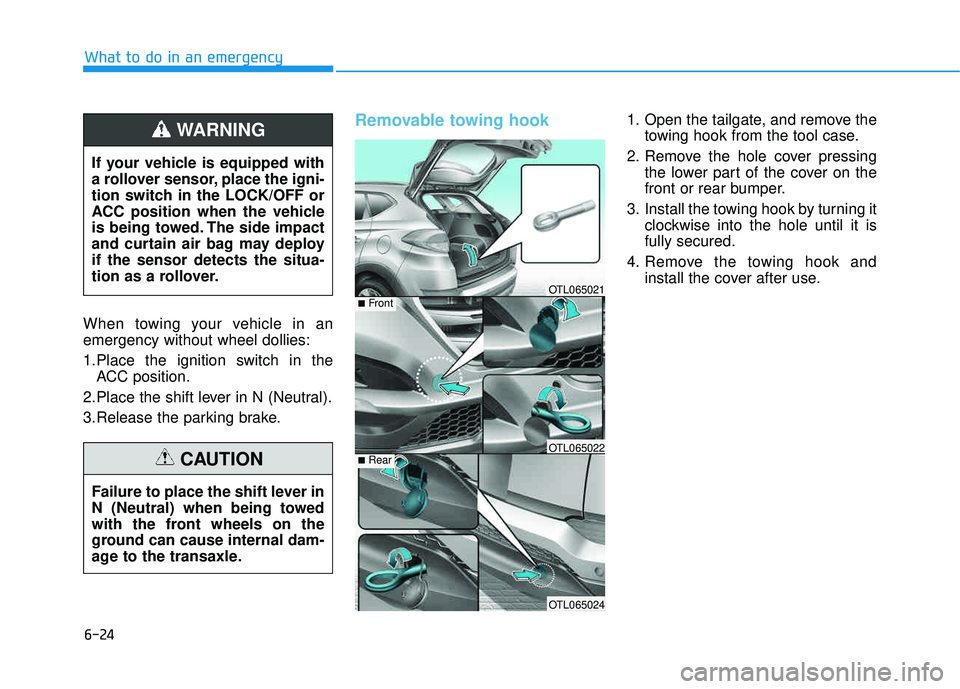
6-24
When towing your vehicle in an emergency without wheel dollies:
1.Place the ignition switch in theACC position.
2.Place the shift lever in N (Neutral).
3.Release the parking brake.
Removable towing hook 1. Open the tailgate, and remove the towing hook from the tool case.
2. Remove the hole cover pressing the lower part of the cover on the
front or rear bumper.
3. Install the towing hook by turning it clockwise into the hole until it isfully secured.
4. Remove the towing hook and install the cover after use.
What to do in an emergency
If your vehicle is equipped with
a rollover sensor, place the igni-
tion switch in the LOCK/OFF or
ACC position when the vehicle
is being towed. The side impact
and curtain air bag may deployif the sensor detects the situa-
tion as a rollover.
WARNING
Failure to place the shift lever in
N (Neutral) when being towed
with the front wheels on the
ground can cause internal dam-
age to the transaxle.
CAUTION
OTL065021
OTL065022
OTL065024
■Front
■Rear
Page 512 of 642
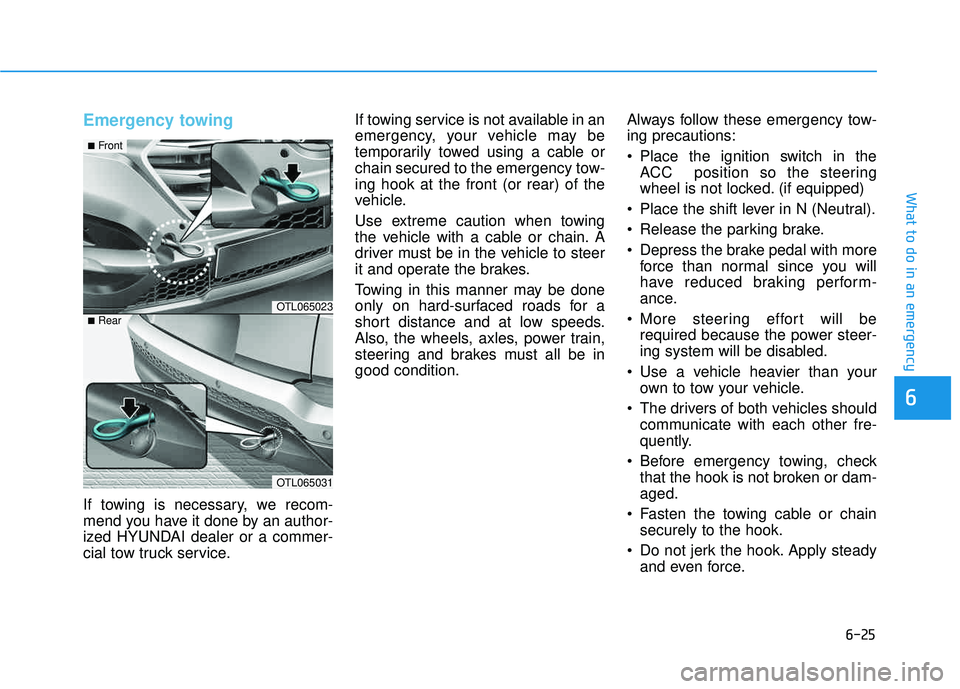
6-25
What to do in an emergency
Emergency towing
If towing is necessary, we recom-
mend you have it done by an author-
ized HYUNDAI dealer or a commer-
cial tow truck service.If towing service is not available in an
emergency, your vehicle may be
temporarily towed using a cable or
chain secured to the emergency tow-ing hook at the front (or rear) of the
vehicle.
Use extreme caution when towing
the vehicle with a cable or chain. A
driver must be in the vehicle to steer
it and operate the brakes.
Towing in this manner may be done
only on hard-surfaced roads for a
short distance and at low speeds.
Also, the wheels, axles, power train,
steering and brakes must all be ingood condition.
Always follow these emergency tow-ing precautions:
Place the ignition switch in the
ACC position so the steering
wheel is not locked. (if equipped)
Place the shift lever in N (Neutral).
Release the parking brake.
Depress the brake pedal with more force than normal since you will
have reduced braking perform-
ance.
More steering effort will be required because the power steer-
ing system will be disabled.
Use a vehicle heavier than your own to tow your vehicle.
The drivers of both vehicles should communicate with each other fre-
quently.
Before emergency towing, check that the hook is not broken or dam-aged.
Fasten the towing cable or chain securely to the hook.
Do not jerk the hook. Apply steady and even force.
6
OTL065023
OTL065031
■Front
■Rear
Page 513 of 642
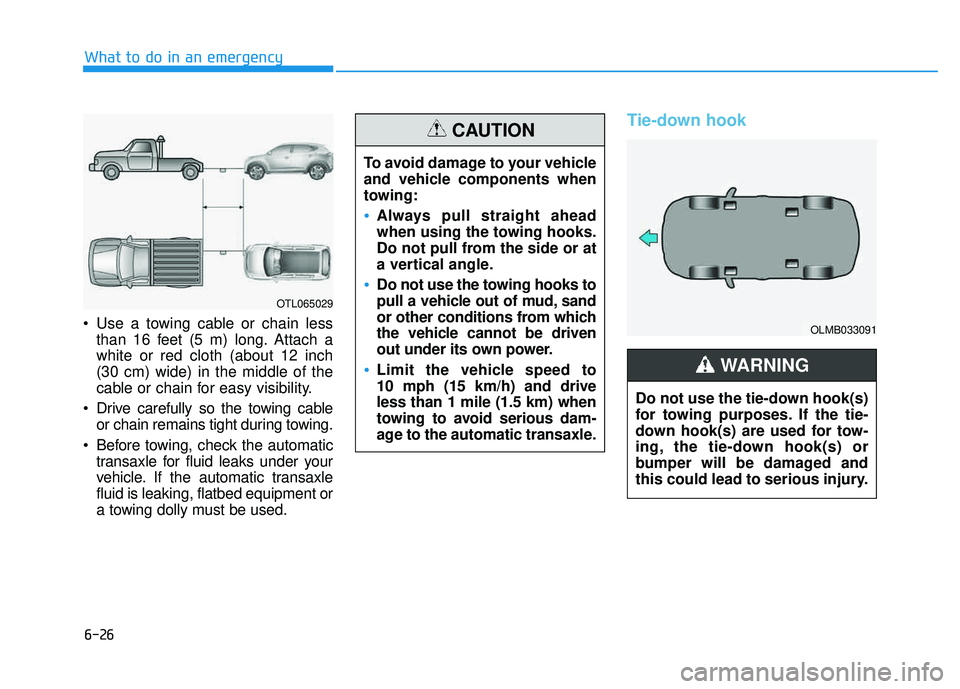
6-26
Use a towing cable or chain lessthan 16 feet (5 m) long. Attach a white or red cloth (about 12 inch(30 cm) wide) in the middle of the
cable or chain for easy visibility.
Drive carefully so the towing cable or chain remains tight during towing.
Before towing, check the automatic transaxle for fluid leaks under your
vehicle. If the automatic transaxlefluid is leaking, flatbed equipment or
a towing dolly must be used.
Tie-down hook
What to do in an emergency
OTL065029
To avoid damage to your vehicle
and vehicle components when
towing:
Always pull straight ahead
when using the towing hooks.
Do not pull from the side or at
a vertical angle.
Do not use the towing hooks to
pull a vehicle out of mud, sand
or other conditions from which
the vehicle cannot be driven
out under its own power.
Limit the vehicle speed to 10 mph (15 km/h) and driveless than 1 mile (1.5 km) when
towing to avoid serious dam-
age to the automatic transaxle.
CAUTION
OLMB033091
Do not use the tie-down hook(s)
for towing purposes. If the tie-
down hook(s) are used for tow-
ing, the tie-down hook(s) or
bumper will be damaged and
this could lead to serious injury.
WARNING
Page 538 of 642
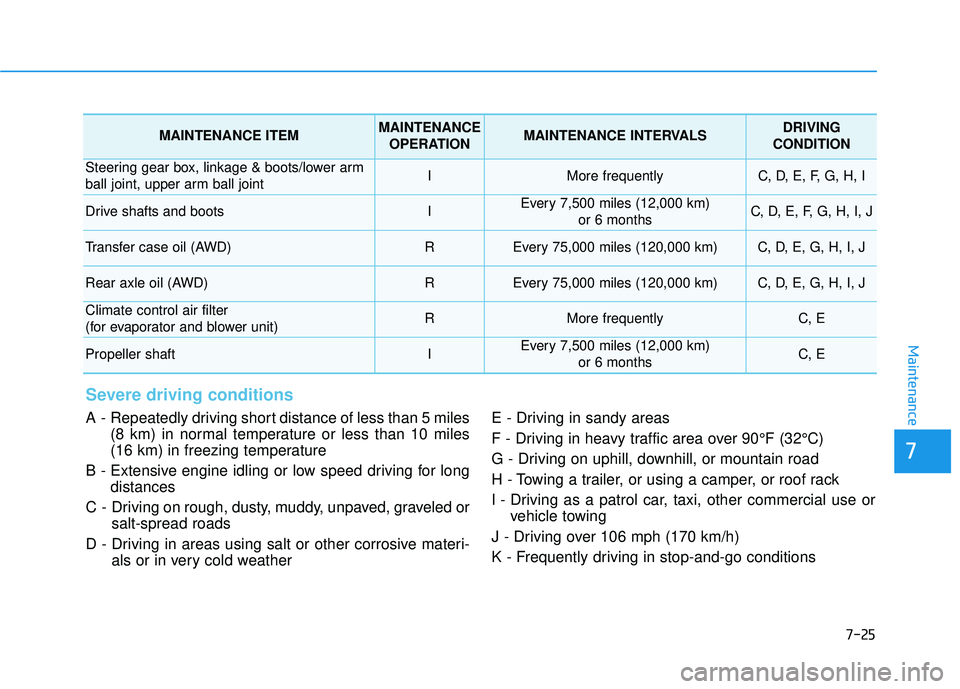
7-25
7
Maintenance
Severe driving conditions
A - Repeatedly driving short distance of less than 5 miles(8 km) in normal temperature or less than 10 miles
(16 km) in freezing temperature
B - Extensive engine idling or low speed driving for long distances
C - Driving on rough, dusty, muddy, unpaved, graveled or salt-spread roads
D - Driving in areas using salt or other corrosive materi- als or in very cold weather E - Driving in sandy areas
F - Driving in heavy traffic area over 90°F (32°C)
G - Driving on uphill, downhill, or mountain road
H - Towing a trailer, or using a camper, or roof rack
I - Driving as a patrol car, taxi, other commercial use or
vehicle towing
J - Driving over 106 mph (170 km/h)
K - Frequently driving in stop-and-go conditions
MAINTENANCE ITEMMAINTENANCE OPERATIONMAINTENANCE INTERVALSDRIVING
CONDITION
Steering gear box, linkage & boots/lower arm
ball joint, upper arm ball jointIMore frequentlyC, D, E, F, G, H, I
Drive shafts and bootsIEvery 7,500 miles (12,000 km) or 6 monthsC, D, E, F, G, H, I, J
Transfer case oil (AWD) REvery 75,000 miles (120,000 km)C, D, E, G, H, I, J
Rear axle oil (AWD)REvery 75,000 miles (120,000 km)C, D, E, G, H, I, J
Climate control air filter
(for evaporator and blower unit)RMore frequentlyC, E
Propeller shaftIEvery 7,500 miles (12,000 km) or 6 monthsC, E
Page 546 of 642
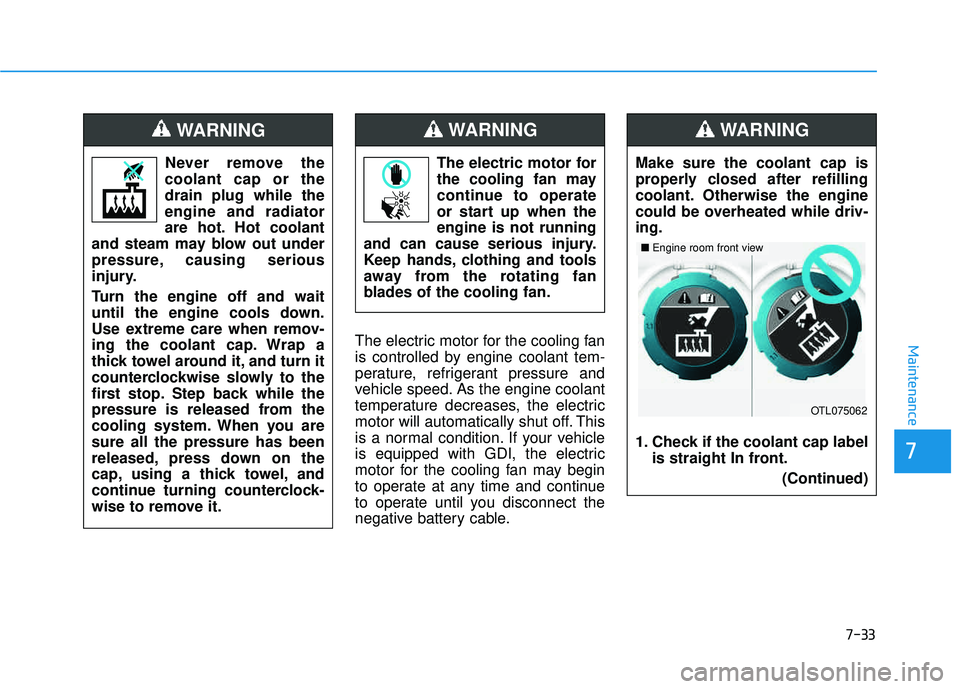
7-33
7
MaintenanceThe electric motor for the cooling fan
is controlled by engine coolant tem-
perature, refrigerant pressure and
vehicle speed. As the engine coolant
temperature decreases, the electric
motor will automatically shut off. This
is a normal condition. If your vehicle
is equipped with GDI, the electric
motor for the cooling fan may begin
to operate at any time and continue
to operate until you disconnect the
negative battery cable.
Never remove the
coolant cap or thedrain plug while theengine and radiator
are hot. Hot coolant
and steam may blow out under
pressure, causing serious
injury.
Turn the engine off and wait
until the engine cools down.
Use extreme care when remov-
ing the coolant cap. Wrap a
thick towel around it, and turn it
counterclockwise slowly to the
first stop. Step back while the
pressure is released from the
cooling system. When you aresure all the pressure has been
released, press down on the
cap, using a thick towel, and
continue turning counterclock-
wise to remove it.
WARNING
The electric motor for
the cooling fan may
continue to operate
or start up when theengine is not running
and can cause serious injury.
Keep hands, clothing and tools
away from the rotating fan
blades of the cooling fan.
WARNING
Make sure the coolant cap is
properly closed after refilling
coolant. Otherwise the engine
could be overheated while driv-ing.
1. Check if the coolant cap label is straight In front.
(Continued)
WARNING
OTL075062
■Engine room front view
Page 548 of 642
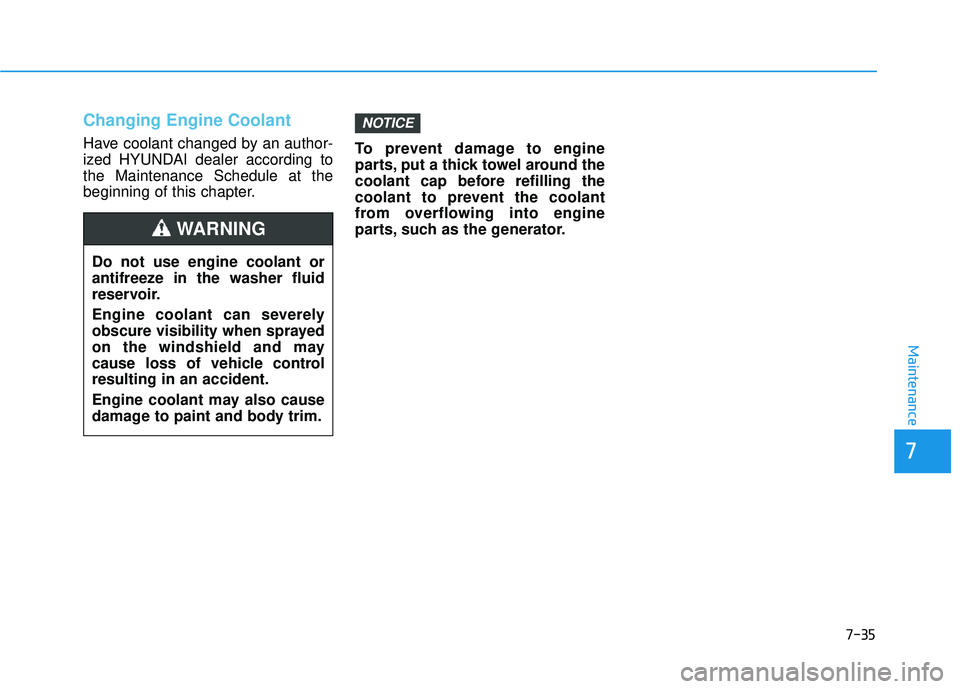
7-35
7
Maintenance
Changing Engine Coolant
Have coolant changed by an author-
ized HYUNDAI dealer according tothe Maintenance Schedule at the
beginning of this chapter.To prevent damage to engine
parts, put a thick towel around the
coolant cap before refilling the
coolant to prevent the coolant
from overflowing into engine
parts, such as the generator.
NOTICE
Do not use engine coolant or
antifreeze in the washer fluid
reservoir.
Engine coolant can severely
obscure visibility when sprayed
on the windshield and may
cause loss of vehicle controlresulting in an accident.
Engine coolant may also cause
damage to paint and body trim.
WARNING
Page 635 of 642
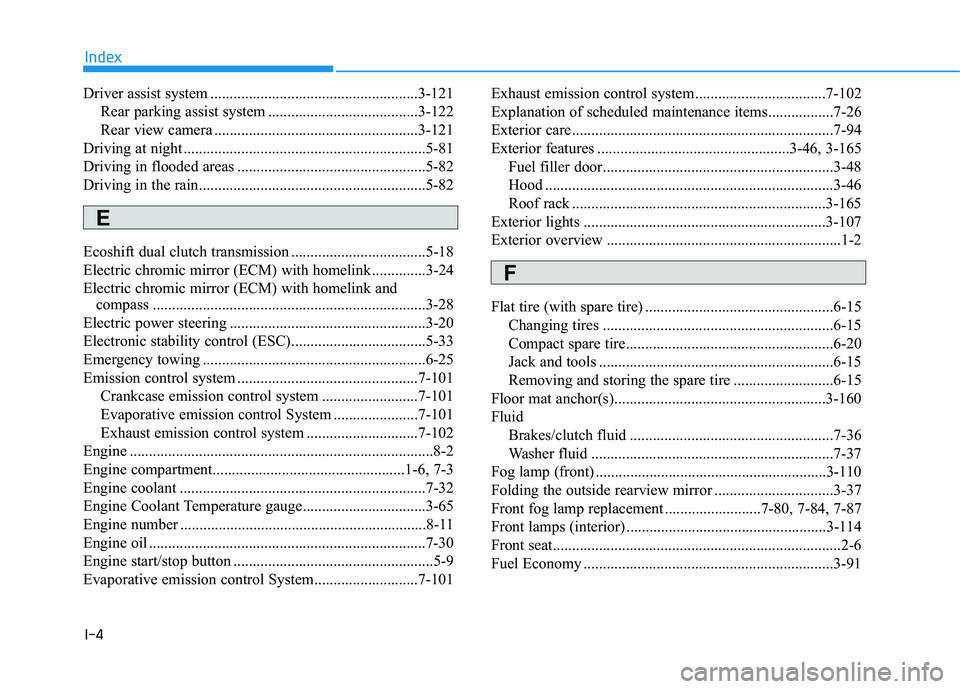
I-4
Driver assist system ......................................................3-121Rear parking assist system .......................................3-122
Rear view camera .....................................................3-121
Driving at night ...............................................................5-81
Driving in flooded areas .................................................5-82
Driving in the rain...........................................................5-82
Ecoshift dual clutch transmission ...................................5-18
Electric chromic mirror (ECM) with homelink ..............3-24
Electric chromic mirror (ECM) with homelink and compass .......................................................................3-28
Electric power steering ...................................................3-20
Electronic stability control (ESC)...................................5-33
Emergency towing ..........................................................6-25
Emission control system ...............................................7-101
Crankcase emission control system .........................7-101
Evaporative emission control System ......................7-101
Exhaust emission control system .............................7-102
Engine ...............................................................................8-2
Engine compartment..................................................1-6, 7-3
Engine coolant ................................................................7-32
Engine Coolant Temperature gauge................................3-65
Engine number ................................................................8-11
Engine oil ........................................................................7-30
Engine start/stop button ....................................................5-9
Evaporative emission control System...........................7-101 Exhaust emission control system..................................7-102
Explanation of scheduled maintenance items.................7-26
Exterior care....................................................................7-94
Exterior features ..................................................3-46, 3-165
Fuel filler door............................................................3-48
Hood ...........................................................................3-46
Roof rack ..................................................................3-165
Exterior lights ...............................................................3-107
Exterior overview .............................................................1-2
Flat tire (with spare tire) .................................................6-15 Changing tires ............................................................6-15
Compact spare tire......................................................6-20
Jack and tools .............................................................6-15
Removing and storing the spare tire ..........................6-15
Floor mat anchor(s).......................................................3-160
Fluid
Brakes/clutch fluid .....................................................7-36
Washer fluid ...............................................................7-37
Fog lamp (front) ............................................................3-110
Folding the outside rearview mirror ...............................3-37
Front fog lamp replacement .........................7-80, 7-84, 7-87
Front lamps (interior) ....................................................3-114
Front seat...........................................................................2-6
Fuel Economy .................................................................3-91
Index
E
F
Page 642 of 642
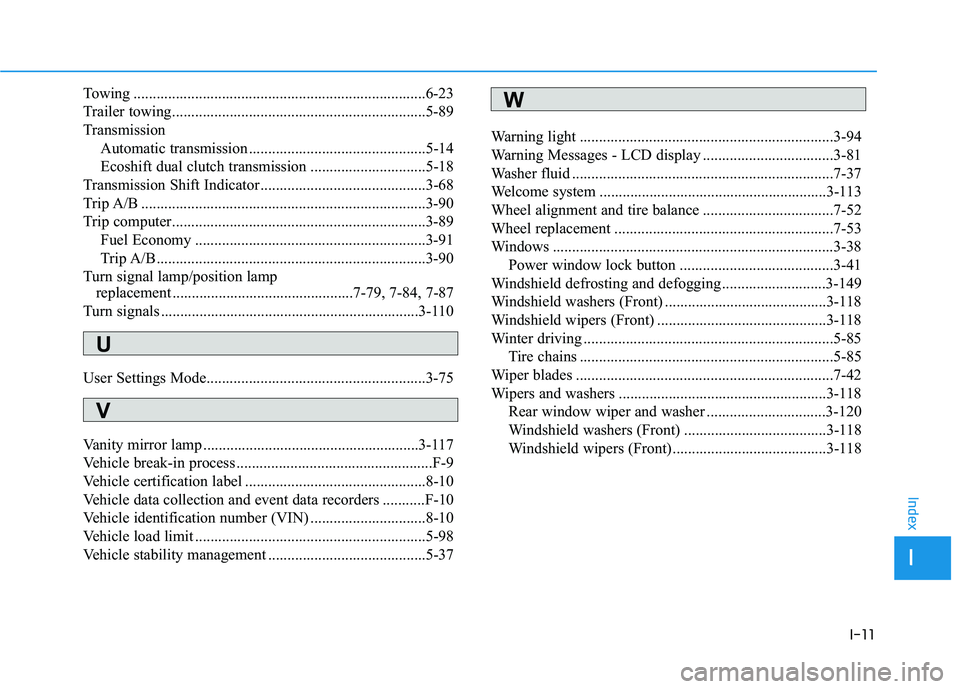
I-11
Towing ............................................................................6-23
Trailer towing..................................................................5-89
TransmissionAutomatic transmission ..............................................5-14
Ecoshift dual clutch transmission ..............................5-18
Transmission Shift Indicator ...........................................3-68
Trip A/B ..........................................................................3-90
Trip computer..................................................................3-89 Fuel Economy ............................................................3-91
Trip A/B ......................................................................3-90
Turn signal lamp/position lamp replacement ...............................................7-79, 7-84, 7-87
Turn signals ...................................................................3-110
User Settings Mode.........................................................3-75
Vanity mirror lamp ........................................................3-117
Vehicle break-in process ...................................................F-9
Vehicle certification label ...............................................8-10
Vehicle data collection and event data recorders ...........F-10
Vehicle identification number (VIN) ..............................8-10
Vehicle load limit ............................................................5-98
Vehicle stability management .........................................5-37 Warning light ..................................................................3-94
Warning Messages - LCD display ..................................3-81
Washer fluid ....................................................................7-37
Welcome system ...........................................................3-113
Wheel alignment and tire balance ..................................7-52
Wheel replacement .........................................................7-53
Windows .........................................................................3-38
Power window lock button ........................................3-41
Windshield defrosting and defogging ...........................3-149
Windshield washers (Front) ..........................................3-118
Windshield wipers (Front) ............................................3-118
Winter driving .................................................................5-85
Tire chains ..................................................................5-85
Wiper blades ...................................................................7-42
Wipers and washers ......................................................3-118
Rear window wiper and washer ...............................3-120
Windshield washers (Front) .....................................3-118
Windshield wipers (Front)........................................3-118
I
Index
U
V
W